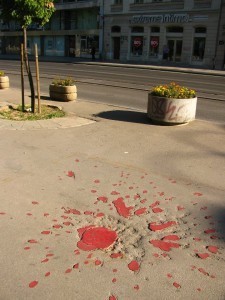Lisa Niver's Blog: We Said Go Travel, page 443
December 11, 2013
Sarajevo Roses
When my husband and I hoisted our backpacks and headed for our three-month European honeymoon, we had no plans beyond our one-way tickets to Thessaloniki, Greece. We were drawn to the freedom of having no plans, reservations, or appointments and enamored with the idea that everything we needed–tent, clothes, camera, notebook–fit neatly into our two travel packs.
It was a month of baklava and sea wind-blown dinners before we took the advice of some fellow travelers and headed for the unknown of eastern Europe, and I will be forever grateful that our lack of plans landed us in Bosnia and Herzegovina.
The name Bosnia conjured images of news footage skirmishes and tanks. It was a war I couldn’t possibly understand at seven–my age when the siege began. I remember it making me sad in that distant, removed way one feels about bad things happening very far away.
We entered the Bosnian countryside from Serbia, a country where the war was a blurb on a placard near the museum exit. Arriving at the Sarajevo bus station, however, we were immediately immersed in the residual reality of that conflict.
On the outskirts of town, apartment buildings were still pocked with bullet holes. Sides of buildings crumbled away from mortar blasts. Yet laundry lines still spanned those apartments, children’s socks and husbands’ undershirts hanging.
We took a taxi to the heart of Sarajevo, and our driver explained to us how his family had lived there–in that city passing our windows–through the siege. To our left was where the Bosnians had lived. To the right had been the militant occupants.
There was nothing of shock value in his stories of having to eat grass to survive. It wasn’t even catharsis. It was just a simple stating of fact.
We couldn’t go past those alleys because it left us exposed to snipers.
We arrived at our hostel and were warmly welcomed as Americans. According to the proprietor, Bill Clinton was a savior. His action ended the nearly four-year war, and with all his hospitality, he seemed to want to confer his gratitude, if not to Clinton himself, to any American that crossed his threshold.
Despite the mass hillside gravesite and innumerable statues and reminders, the closer we got to downtown, the less physical evidence remained of the war. Buildings had been repaired. The streets had been repaved. In the lively Turkish Quarter, winding through back streets of hand-pounded metallic tea sets and hookah bars, it was easy to lose yourself in the modernity and fun of the city. Surrounded by its green hills, I was taken aback by the beauty of the place. It seemed wrong, or at the very least incongruent, for a place with its history to be allowed to be so beautiful. Yet it was. Stunningly so.
But even in the most carefree bars, the city always remained of two worlds–healed yet mindful that true healing means never forgetting. In the aftermath of the conflict, when the streets were littered with spent bullet casings and mortar shells, Sarajevo did the only thing it could do.
The citizens took those shells and painted them in black and gilded filigree. They drew the city skyline in artful, careful strokes. From the physical remnant of death came art.
Walking on the sidewalks downtown, there are panels of concrete now known as Sarajevo Roses. When mortar shells collided with asphalt, a unique pattern of destruction emerged that looked almost floral. The resulting holes were filled with a red resin to commemorate where one or more lives were lost to the mortar fire. Death and beauty under our feet.
I am so grateful to have had the opportunity to see Bosnia, to hear the stories from the mouths of the people who lived it, to be embraced without resentment by people who risked their lives for water while I climbed trees and complained about my times seven multiplication tables.
I am grateful the people know how to embrace new life when it would be so easy to wallow in the staggering loss of it. I am grateful something like the Sarajevo Rose exists–a defiant rebellion against sorrow–and that my feet passed over it too.
About the Author: Liz Herrin is a freelance writer and editor who has had the privilege of traveling the world for the past five years with her husband. She holds an MA in creative writing and currently resides in the most beautiful place in the world–Seattle, Washington.
The post Sarajevo Roses appeared first on We Said Go Travel.
Summer in West Australia
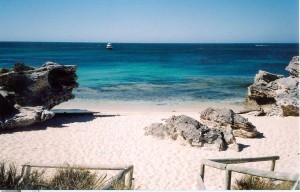 A famous Australian Playwright -Dorothy Hewitt commented that it’s going to the ‘blonde’. Which means that grasses and shrubs are dried because summer heat is a natural version of peroxide, bleaching the color from everything? Eventually even the suburban front lawn becomes beige and hibernates in its summer coat.
A famous Australian Playwright -Dorothy Hewitt commented that it’s going to the ‘blonde’. Which means that grasses and shrubs are dried because summer heat is a natural version of peroxide, bleaching the color from everything? Eventually even the suburban front lawn becomes beige and hibernates in its summer coat.
People in Sydney people would ask, “Where are you from?” Naively I replied, “The west”. To which they would assume I must mean the western suburbs. It seems that for many in Australia the Blue Mountains marked the edge of all existence.
Eager to enjoy a nostalgic journey of Christmas on the Australian west coast we took a day time flight across this wide brown land. Each day dawned with blue skies, heated to the edge of bearing, followed by our lazing into a cloudless afternoon, slightly cooling westerly breezes and awakening rested for the same again, then again, then again. I enjoyed a strong sense of familiarity through knowing that the summer wind on the Australian west coast has no obstructing mountains (WA does do blustery) will predictably be from the east, laden with a tang of hot, blonded wheat fields, in the morning. Then will turn into a sea breeze at some stage during the afternoon. On this summer vacation my husband (born in Sydney with a surfer-dude childhood) remarked, “that wind will blow off shore all day”. But I had insight from local knowledge I knew full well to predict with confidence, “no it isn’t”, sure enough at 11am the beach-side flags floundered and hugged their poles for a about half an hour and then just following lunch I was able to enjoy a “I told you so” moment. But while living in Sydney I’d forgotten just how windy the west coast was until we tried to sleep. In an effort to enjoy the cooler evening we’d opened windows and experienced constantly rattling vertical blinds being tossed about in breezes they call the Fremantle Doctor.
Watching the sun set over the ocean is a quintessential WA summer holiday experience. Very few Australian’s have travelled to this “most isolated capital city in the world…” but those who have, including us, recall with eagerness how the sky changes through a plethora of tones from daylight to night on the western sea shore. In daylight the white sands are even more brightly blond than the summer grass, the water cerulean. While we watched the setting sun becomes a red-golden orb that sinks with an almost audible hiss into the Indian Ocean horizon. I remember a childhood experience of the double whammy sunset in the scarp-edge John Forest National Park where my family watched both the sun-set plus illumination of city lights an orbiting astronaut named “city of lights”. From our vantage point there was a fairy world below on an indigo carpet, and flame related rainbow overhead. On our recent sojourn we paired with the close-of-day experience as spectators at the daily ‘going down of the sun’ with fish and chips consumed out of a steaming hole in a paper packet. It is also possible to watch this event over cocktails at Cable Beach many thousands of miles and dollars worth of air-fare away. Or opt for a cold beer in numerous bars that faced west taking advantage of a view over the Indian Ocean that nothing interfered with for thousands of oceanic kilometers.
Our summer in the west was also synonymous with food pleasures. We enjoyed picnics by the river side; meals on the edge of various water courses; late afternoon dips in the cleansing surf before the everyone trundled up the sand hills, dragging damp towels, sand clinging, salt crusted, to pack the now empty esky (chilled-bin) and various bits of beach paraphernalia into the car and return to a still hot house, opening it up to the potential of a ‘late weak sea breeze’. You could almost smell the way another day in the sun was turning grass crisp and flaxen!
I will try not to evoke the expatriate ‘sand-groper’s’ everything was wonderful back there mindset. But I already miss the long, hot; dry that marks my West Australian summer holiday.
About the Author. Karen Leathlean grew up on the west coast of that ‘wide brown land’, ’great southern land’ – Australia, but has travelled in Asia, America and New Zealand. She is a teacher and triathlete. Her fiction writing work can be found on various websites or in magazines.
The post Summer in West Australia appeared first on We Said Go Travel.
India: Sunrise at the Ganges
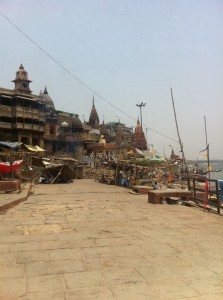 The smoke from the funeral pyres danced in the rising sun, cascading downstream with the river and rising above the morning bathers. The smell of burning wood and incense hung in the air, stagnant, as the sun peeked over the horizon and reflected off the rippling currents. Crows flocked at the piles of ash and bone that used to be human. I trailed my hand absent-mindedly along the cool surface of the water. The boat we were in was small and shallow, the size of a canoe, and rocked gently in the glow of dawn. I turned to my friend.
The smoke from the funeral pyres danced in the rising sun, cascading downstream with the river and rising above the morning bathers. The smell of burning wood and incense hung in the air, stagnant, as the sun peeked over the horizon and reflected off the rippling currents. Crows flocked at the piles of ash and bone that used to be human. I trailed my hand absent-mindedly along the cool surface of the water. The boat we were in was small and shallow, the size of a canoe, and rocked gently in the glow of dawn. I turned to my friend.
‘Ready?’
She nodded. We slid off of the boat into a shallow part of the river and waded further in, the water still warm from yesterday’s harsh heat. Women brushing their teeth at the banks smiled and pointed us out to their children, bemused by the sight of two little white girls paddling in the Ganges. I tried to push back thoughts of stepping on dead bodies as the river bed grew slimier and, when I could no longer touch the bottom with my toes, I took a breath and let myself sink into the holy waters. It was silent, calm; completely different to the world above.
By the time we swam back to shore the sun had already scaled up the pink sky and the crowds at the banks had doubled in size. We exchanged a few soggy rupees with a street vendor for small cups of chai before clambering back into our boat. The river was alive with sounds of neighbour’s gossiping, naughty children being scolded and tour groups ‘ooh-ing’ over historical facts and points of interest.
At one of the ghats up ahead a funeral ceremony was taking place and we asked the man steering our boat to stop. We watched as people gathered on the banks. Four men dressed in white placed a limp body, their mother, onto a concrete slab at the river’s edge. She was wrapped in beautiful saris, elaborate and glittering but they were sobered by the white of her face. I strained to get a better look and realised I’d never seen a dead body before. The men slowly and meticulously built a platform of logs to lay her on, a final gesture of love. No one was crying, worried that tears would bring trouble for her soul.
Prayers were said and the fire was lit. The noise from the rest of the world slipped away as I continued to watch, mesmerized. The growing flames engulfed her, her saris blazing. Clouds of thick, choking smoke obscured the mourning family; the crackle of the fire grew louder.
There was a taste of mourning in the air, a sinking feeling of hopelessness as her body went up in flames, but the smoke clearing was like a sigh from the universe; people dried their tears as her smouldering remains were pushed into the waters, her soul cleansed and free to pass on to another life. A small boy handed out candles on dishes decorated with flowers. They were lit and sent into the river, floating serenely before going under, and I realised the spiritual significance of what I’d just seen. It was raw, and humbling. We remained silent for a long time.
About the Author – My name’s Alice Berry and I’m a 21 year old creative writing and philosophy student. I love travelling and want to spend my life exploring the world, although I’m currently living in rainy Bath. I’m a travel writer for Pie Magazine and an avid Kerouac enthusiast.
The post India: Sunrise at the Ganges appeared first on We Said Go Travel.
Argentina: Mi Buenos Aires Querido
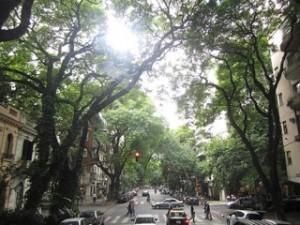 My entire life growing up, hearing stories about Argentineans, I was convinced they had to be the most patriotic race of all. It must have been the constant display of light blue and white ribbons hanging from every imaginable personal object, the inevitable appearance of the Argentinean futbol jersey at any and every South American event and the pride-infused voice of an Argentinean answering the most commonly asked question in Sydney.
My entire life growing up, hearing stories about Argentineans, I was convinced they had to be the most patriotic race of all. It must have been the constant display of light blue and white ribbons hanging from every imaginable personal object, the inevitable appearance of the Argentinean futbol jersey at any and every South American event and the pride-infused voice of an Argentinean answering the most commonly asked question in Sydney.
‘So, what nationality are you?’
I suppose all migrants feel that way about their homeland, having left it so far behind, for so many reasons. These patriotic markers perhaps stem from a deeply buried fear of memories fading, bit by bit, slowly distorting and eventually disappearing like melting sand castles in high tide.
As I sit in this Buenos Aires restaurant, about to devour the steaming plate of home-made pasta or ‘tallarines’ as they’re called here, accompanied only by a glass of house ‘tinto’, I am reminded by the multitude of shades and facial features that surround me, that like Australia, this country too has a history of immigration centuries beyond Colombus’ arrival; where the many European foreigners and indigenous faces of the land became the base ingredients of Argentinean identity, simmered on a low heat for decades, gradually reducing the broth of language, and fusing the aroma of customs to create today’s distinctly Argentinean flavour.
“This is delicious!” I remark internally. The tallarines and their ‘tuco’, or sauce, are exactly like the ones my Grandmother makes, only she lives on the other side of this uniquely silver-toned river. I remember slurping them up, competing with my cousin Javier to see who could finish them first, so we could run out into the open backyard and play ‘till late amongst the endless rows of lemon and fig trees. I find it funny that I remember that. I was only four at the time. It is one of only a handful of memories of my flash of a life in Uruguay, Argentina’s sister land. Although they are not identical, they share significant historical and cultural DNA.
Before I can finish that thought, my waiter returns to check on my eating experience. I have never been so impressed by the service. He remembered every detail of my order and the two tables beside mine by heart and served them all with a quick wit and a Buenos Aires smile.
I couldn’t resist sticking around for a ‘cortado’- the perfect combination of a latte and a cappuccino, served in a stylish glass cup, while I skimmed through a tour brochure.
He spotted my map resting quietly on the table and offered me help with directions. ‘Plaza de mayo?’ I asked pleasantly surprised.
He offered to walk me himself as his shift was (conveniently) about to end. I should have remembered the advice I’d been given before leaving on just how good Argentinean men are at charming you with their good looks and utmost hospitality. But, just as conveniently for me, I forgot, and took this gorgeous man up on his offer.
As Ariel and I walked and chatted through the ample tree lined- streets of this old city reminiscent of a Parisian painting, I took in the essence of its timeless beauty. And its melancholy. A super metropolis with a history of promise.Once a new world power offering hope to European civil war escapees, today a third world paradise of sorts – for some. For others, it is a daily struggle; an increasingly violent jungle of possibilities enmeshed with ever-elusive hope.
Arriving at the immense plaza, where grieving mothers continue to march, decades after their sons’ and daughters’ disappearances, I was reminded of this country’s solemn political journey and decided to part ways with Ariel. He was intent on skipping the tour for a drink at the local ‘boliche’ but as tempting as it was to party until dawn, like I’d seen many ‘porteños’ do, I had so much more to explore in this fascinating city.
I gave him a ‘gracias’ kiss on the cheek, as is custom, and set off amongst the ocean of pigeons visiting the plaza that day.
I now know why the famous Tango ‘Mi buenos aires querido‘ – My beloved Buenos Aires, became an anthem of sorts. It provokes in you a sense of passion, drama, grief and undying gratitude. It’s an uncanny reflection of the breathtaking paradox that is Buenos Aires.
About the Author: Natalia Fernandez is an aspiring travel writer from Sydney, Australia. The daughter of South American migrants, her journeys began at a young age. As an adult, travelling, alongside her love for writing poetry and prose, became her obsessions. Combining her passions is a lifelong dream for Natalia who believes the world and its beautiful complexities are the physical route to discovering the secrets of the human spirit.
The post Argentina: Mi Buenos Aires Querido appeared first on We Said Go Travel.
December 10, 2013
Tzintzuntzan Cemetery, Mexico: A Night Among the Dead
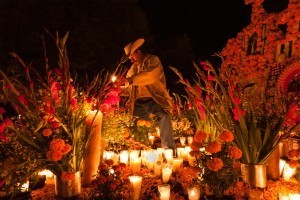 Maria and her baby brother Eugenio lost their mother in April this year. The twelve-year-old purepecha girl holds him on her arms while their grandmother places cempazuchitl flowers and lighted candles on top of their mom’s grave. Midnight is approaching and temperature is rapidly dropping below the freezing point. A cold drizzle has transformed the ground into a thick red mud, making it almost impossible to walk. Despite the weather conditions the family tells me they will not move from the tomb until morning. A picture of the young woman stares at us. She is now among us. It’s time to be quiet.
Maria and her baby brother Eugenio lost their mother in April this year. The twelve-year-old purepecha girl holds him on her arms while their grandmother places cempazuchitl flowers and lighted candles on top of their mom’s grave. Midnight is approaching and temperature is rapidly dropping below the freezing point. A cold drizzle has transformed the ground into a thick red mud, making it almost impossible to walk. Despite the weather conditions the family tells me they will not move from the tomb until morning. A picture of the young woman stares at us. She is now among us. It’s time to be quiet.
Indigenous people of Mexico and Central America believe that on the night of November 1st the souls of their beloved ones descend to earth to be with them once again. They place offerings on the graves of the dead to please them and guide their way back from the spirits’ world to earth. This belief, whose origins can be traced back 2,500 years, has one of its most genuine expressions at Tzintzuntzan graveyard, in Michoacan State, where a large community of Purepecha indians safeguard their ancient traditions and are reluctant to accept the intrusion of the modern world into their lives.
Visiting Tzintzuntzan cemetery on the Day of the Dead is something I had been wanting to do for a long time but have avoided because of the intense violence at the region inflicted by drug cartels. It’s not safe being here today. I don’t feel any relief from the presence of a military operation consisting on, at least, forty soldiers armed with Browning M2 machine guns and M40 tanks. They have orders to protect the 20,000 estimated tourists that are visiting the town this day but because of the army’s reputation of corruption and complicity with crime they are making me feel more anxious than safe.
The air is dense. A mixture of woodsmoke coming from bonfires, burned incense and copal, and candle smoke makes it hard to see and dries my eyes. Despite the darkness of midnight the cemetery shines with an orange glow. Cempazuchitl flowers, with their tangerine color like sunbeams, are believed to guide with light the way for the spirits back to us.
The decoration of the tombs is nearly done. Entire families have been setting out the traditional paraphernalia since yesterday’s morning. It’s hard work. Pan de muertos (bread of the dead), mescal, beer and tequila, salty and sweet tamales, bananas, apples and guavas, orange cempazuchitl, white gypsy and purple cockscomb flowers, lighted candles, Christian crosses, framed pictures of the deceased, the murmur of prayers, mariachis, yellow confetti, sugar skulls, and the omnipresent Coke create a cornucopia of colors, sounds and smells, each with the purpose of either pleasing or guiding the deceased back home on this freezing night.
Every epitaph is handwritten and misspelled. Indigenous people of this region have historically been ignored by the government and their schooling isn’t long or good enough to learn how to write. Many of the deceased are children whose deaths could have been prevented in the first world. A vast quantity of the graves belong to very young men. I wonder how many of them were victims of the cartels.
Each tomb has a picture of the dead. There are grandparents buried together, young mothers, babies, wives, sons and daughters, siblings. Most families seem to accept the death of their beloved ones and happily celebrate around the tombs with dinner, alcohol, laughter, mariachi music and good old talk. Nevertheless and despite this joyful celebration of death being deeply rooted in Mexican culture, there are a few people who don’t seem to be happy at all.
There is a man holding his newborn baby in his arms, staring at the picture of his wife. He doesn’t look away, he isn’t distracted by other families’ celebrations, and he doesn’t even notice my presence. He just stares at his beloved one and talks to her in silence. Sometimes he closes his eyes and prays. Tears roll down his face. I read the epitaph: she died last month while giving birth.
Octavio Paz, the Mexican Nobel Laureate, once said that for Mexicans death isn’t the end of life but the next phase of an infinite cycle. The opposition of life and death isn’t as absolute for them as for other cultures. Life is prolonged in death.
For me, an atheist who doesn’t believe in spirits that come back to earth, the Day of the Dead still signifies something: it’s a reminder. Today I’m here, celebrating above the ground, but soon I’ll be immobile below. When that day comes I can only hope to be remembered like this by the ones who once loved me.
About the Author: Despite being 5’2’’, Ana Lenz isn’t afraid to travel all by herself. She began writing stories from the moment she learned how to write. Since she discovered she could combine her passion for writing with her passion for traveling, she quit her 9 to 5 job to work as a freelance travel writer.
The post Tzintzuntzan Cemetery, Mexico: A Night Among the Dead appeared first on We Said Go Travel.
France: Burning Waves
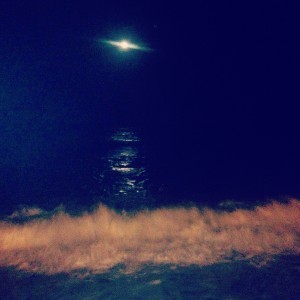 The word “burning” normally brings about visions of fire, of heat and of light. Of licking flames, flickering tongues momentarily illuminating a warm brick hearth or charring wood until a bed of glowing embers is born beneath. The word “burning” does not normally haunt the same descriptions as do “dark” and “wet”.
The word “burning” normally brings about visions of fire, of heat and of light. Of licking flames, flickering tongues momentarily illuminating a warm brick hearth or charring wood until a bed of glowing embers is born beneath. The word “burning” does not normally haunt the same descriptions as do “dark” and “wet”.
But if ever there was a place for exceptions, the south of France would be it.
The coast of Antibes, a small seaside town that retains the sleepy Provencal visage its neighbors Nice and Cannes have lost to the glitz and glam of the French Riviera, was deserted but for my lone silhouette, barely visible against the sand in the moonlight. Stiff gusts of salty October air whipped tendrils of hair from my face, and rustled through the palms behind me. And in front of me, the waves burned.
The dark waters of the Mediterranean were alight with captivation, with entrancement. Fiery; they set every particle of my being ablaze with exhilaration, catching me in an under-toe that pulled me further and further out with every crashing crest, dragging me into an overwhelming sense of being acutely alive.
Immense rollers moved with an alluring, captivating rhythm for as far as I could see in the darkness, silver moonlight pirouetting a wild ballet across their curls.
Whitecaps roared to shore, pounding the beach before retreating back to their own domain, leaving grains of sand shivering with the impact. The violence of the surf was seductive, its danger a siren’s call begging me to join its frenzied dance.
But the sea held me captive, holding me still before its vastness, spellbound by its might.
My shoes had long since come off and my feet buried themselves more securely into the sand, stationing themselves firmly in the earth, as if to head off my reckless heart, as if they knew it would rather be beating amidst those waves than nearly anywhere else. I satisfied myself with watching, mesmerized, not bothering to wipe the constant spray from my cheeks.
Far from my home on the opposite end of a different ocean, I’d never felt smaller than at this moment, just beyond the reach of the Mediterranean’s waves. I’d never been so intensely aware of the thousands of miles separating me from the place I grew up in the United States, or how many fewer miles there were between myself and places I’d always considered to be so distant they were hardly even real-Africa was just across the waters my eyes refused to tear themselves away from; perhaps holding some innate fear that in so magical a place, I had become apart of those exotic backgrounds I’d always imagined, a thread woven into those colorful tapestries that were never quite solid, never quite real. But if I was woven in, the stitch was not a neat one. There would be no simple retracing of a shuttle’s motion over a loom, no untangling knots that had been this firmly tied. My breath was in time with the waves falling against the sand, and with every inhale and exhale; I felt the sea burn a searing path ever deeper across my blazing heart.
About the Author: Katherine Miller is 20 years old, and studies at Marist College. She is currently having the time of her life studying abroad in Antibes, France, eating an absurd number of croissants, and watching the waves wash up against the shore of the beautiful Côte d’Azur.
The post France: Burning Waves appeared first on We Said Go Travel.
A Mekong Adventure: Exploring Paradise in Laos
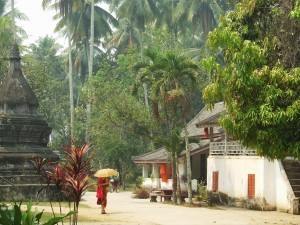 There we were floating down the murky greyish waters of Mekong. Our little plastic kayaks were the only barrier between us and the watery world around when the black rain started falling upon us from nowhere. It was a pretty surreal experience, dream-like I would add, if you are the kind of person to dream random and weird dreams. But it was also profoundly beautiful in a way, as beautiful as it was scary.
There we were floating down the murky greyish waters of Mekong. Our little plastic kayaks were the only barrier between us and the watery world around when the black rain started falling upon us from nowhere. It was a pretty surreal experience, dream-like I would add, if you are the kind of person to dream random and weird dreams. But it was also profoundly beautiful in a way, as beautiful as it was scary.
Because, what was falling upon us was ashes.
And soon, as we made our way around the river bend, the vegetation along the banks might have been burning.
How did we get there you may wonder?
By plane. A small toy-like propeller plane.
As we were approaching to land it was already late in the evening, and the sight below was little short of magical. I am not sure what we were expecting, but we were certainly not expecting to see a few warmly, some may say dimly, lit streets with just 3 to 4 vehicles moving about. One of the biggest cities in the country – Luang Prabang, was so cozy and beautiful in its simplicity. We were instantly charmed.
Upon waking up and getting out in the street the next day, I could not believe my eyes. The fact is that I never in my life took time to stop and portray paradise, but this, a sudden realization swept over me, hit really close to the mark. Trees full of flowers and fruits intertwined harmoniously blending with temples and houses. And just a short walk further we were rewarded with glimpses of the quietly flowing Mekong. For the first time in our South-East Asian adventure we found a peaceful and serene refuge. No one was pulling our sleeves, shouting or rushing us to take their goods or services. Tuk-tuk drivers would surrender before we even had the chance to say no. The people were kind and cheerful but pretty quiet. And I became enchanted – by the place and its inhabitants.
A roller coaster of random experiences ensued, from taking a stroll in the lovely colorful night-market and becoming spellbound by the fairy-lights, to waking up in the middle of the night to a flood in our room. We explored a variety of magical fruit juices (those things are downright magical, especially when made with soy-milk and coconut water), discovered beautiful temples, many of which we had all for ourselves, and ended up swimming and basking in dreamy waterfalls. It was a weird mix of peaceful and intense, and it was lots of fun.
Finally, to spice things up, we decided to go on a tour – and chose a kayaking tour down the Mekong. There were five of us including our guide, and we had most of the majestic scenery to ourselves. Truth to be told, we paddled for hours, but in the end, due to our general lack of stamina (something to work on), we ended up mostly just floating downstream.
Now we reach the part with the ashes. It turns out that early March in these areas is the period in which farmers prepare to cultivate crops by pretty much burning everything around, and the little town of Luang Prabang gets enveloped by smoke. It also turns out that that was the time we chose for our visit. The tours, however, still go on. That is how we ended up having our otherworldly experience, watching as the big and small chunks of ashes fell from the sky, ending up on the river surface.
I was awestruck by this experience – even though it was all sorts of wrong. I am truly grateful that I not only got to experience the beauties and wonders of Luang Prabang, but also experienced first-hand the other side of its story, not often shared with tourists, which may require more attention and awareness. I am grateful to all the amazing Laotians who made our stay in their town so pleasant and unforgettable. I am grateful that they have taken such good care of their heritage, for all of humanity to enjoy today. Luang Prabang may not have mega-structures, but its serene atmosphere and its proximity to nature make it a unique and wonderful gem, and as I decided soon after, my Shambala. And now I know that the outskirts of my Shambala are occasionally burning.
I am profoundly grateful that we did not go for the tour package that included hiking, because those people ended up running through the burning forest for their lives.
I really hope one day to return to my paradise again, and see it flourish and prosper without the thick veil of smoke. I will be dreaming of you, Mekong, till then.
About the Author: Biljana Novkovic, PhD in Environmental Science, moved to Japan for her graduate studies in 2008, and has since travelled in Asia whenever the opportunity presented itself. She loves hiking, traveling and writing.
The post A Mekong Adventure: Exploring Paradise in Laos appeared first on We Said Go Travel.
New Zealand: Lake Tekapo, once again
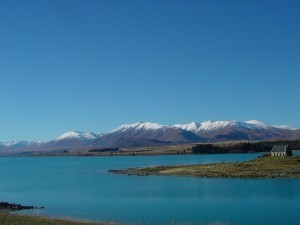 I was in familiar territory. In the words of our bus driver who was playing tour guide, on my left was low grass while much farther on my right was Mount Cook, New Zealand’s tallest mountain. “Now isn’t that a lovely view, ladies and gentlemen?” he asked over his microphone. Yes it is, I thought.
I was in familiar territory. In the words of our bus driver who was playing tour guide, on my left was low grass while much farther on my right was Mount Cook, New Zealand’s tallest mountain. “Now isn’t that a lovely view, ladies and gentlemen?” he asked over his microphone. Yes it is, I thought.
We entered a fork in the road and came to a small town. All along the main street were the usual – a general store, a bakery, restaurants and cafés.
The bus stopped and our driver turned to us. “All right, this is Tekapo. We’re stopping here for a while then it’s off to the lake but if anyone wants to walk there, I’ll see you in fifteen minutes.” I left in a flash.
I had first come to New Zealand when I was twelve. My parents packed my brothers and I into a plane and upon landing at Christchurch, rented a bright yellow Mazda 323 and drove us all over the country. For that reason alone, I thought my parents were the coolest old people around. They still are.
It was late afternoon when we arrived at Lake Tekapo back then. We were headed for Mount Cook when my father, who had been driving for hours, took that same fork in the road. “There’s a very nice lake here where we can stop for a while,” he said.
This ‘very nice lake’ had the most crystal clear water I had ever seen. It took my breath away. My twelve-year-old eyes had never seen such beauty- the way the sunlight reflected on the surface and how turquoise blue the water was. And beyond this lake, far away, was a row of mountains, their peaks covered in snow.
“What is this lake, Papa?” I asked.
“This is Lake Tekapo. Do you like it?”
“I love it!” I cried, my voice cracking with joy.
There was a sort of ledge nearby so I sat down after a while. I noticed a small stone house and a statue of a dog but had no idea what they were. I don’t remember how long we stayed there but it seemed like ages. A child doesn’t need to worry about time.
“We have to go,” my mum finally called. “We don’t want to reach Mount Cook too late, it can get really cold there.” And so we left.
I was still thinking of the lake when we reached Mount Cook. In our freezing motel that night, I asked my dad for his guidebook and read about the area.
I learnt that we were in a region called the Mackenzie Country, named after a sheep rustler called James Mackenzie. The statue was a tribute to the loyal sheepdogs that had helped shepherds in the area. The stone hut was the Church of the Good Shepherd and was built in 1935. And of course there was the lake itself. I saw a photo of Lake Tekapo and knew I had to go back one day.
And this was where I was headed, eighteen years later.
I had scrambled out of the bus as soon as our driver said we could get to the lake on foot. Fifteen minutes. Is that long enough? I thought, tripping over my feet.
The road towards the lake went up a slope. There were yellow and purple wildflowers growing on both sides and I stopped to pick some for my mother, who presses flowers in her books. I hurried on. It shouldn’t be too far now.
Then the road disappeared and a familiar blue hit my eyes. The surface of Lake Tekapo, which I now knew was covered with fine rock dust carved by glaciers in the Alps, sparkled in the afternoon sun. The water was as blue as I remembered it. My heart soared and suddenly I was no longer the adult who had quit her job to travel. I was twelve again.
When our bus left Queenstown that morning, I had wondered whether my memory of the lake was accurate or if my childish brain had simply been high from being on holiday. I still have the notebook I wrote all those years ago and under ‘Lake Tekapo’ was: ‘Oh wow it was really cool! The view was so beautiful!!!’ That was all I had written.
But my memory of the place had been accurate. I hadn’t been very eloquent, but maybe eloquence was unnecessary.
A familiar sound reached my ears. It was our bus rumbling up the slope.
The bus stopped by the lake for less than ten minutes, just enough time for us to pose and take photographs.
As he drove away from Lake Tekapo, our bus driver said: “Now wasn’t that lovely, ladies and gentlemen?”
Oh yes, it was.
About the Author: Anis Ibrahim is a freelance writer from Kuala Lumpur, Malaysia. She worked as a journalist for nine years and has a regular travel column in the New Sunday Times. Follow her on her blog, Five Feet Flat or on Twitter: @AnisIbrahim
The post New Zealand: Lake Tekapo, once again appeared first on We Said Go Travel.
December 9, 2013
Scotland: Rest and be Thankful
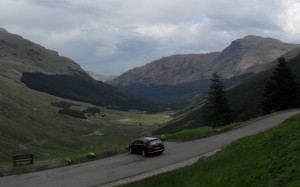 In the distance the late morning mist embraced the tip of Ben Nevis like a lover. The sun tried feebly to break through the dark clouds and the rain came down in a lazy drizzle, oblivious to the fact that it was my birthday and the sun should have been given a chance. I refused to pull up the hood of my raincoat. If the weather could be obstinate, so could I! Fat, wet drops clung to my eyelashes and blurred my vision for a moment. I closed my eyes and breathed in the scent of the moist earth. When I opened them again I saw a stray ray of light seeping through and touching the side of the mountain. Then the mist lifted and the jagged tip of Ben Nevis presented itself in its quiet and unassuming beauty. Its stillness drew me in and once again I listened to the song of the wild that brought me back to the Highlands time and time again.
In the distance the late morning mist embraced the tip of Ben Nevis like a lover. The sun tried feebly to break through the dark clouds and the rain came down in a lazy drizzle, oblivious to the fact that it was my birthday and the sun should have been given a chance. I refused to pull up the hood of my raincoat. If the weather could be obstinate, so could I! Fat, wet drops clung to my eyelashes and blurred my vision for a moment. I closed my eyes and breathed in the scent of the moist earth. When I opened them again I saw a stray ray of light seeping through and touching the side of the mountain. Then the mist lifted and the jagged tip of Ben Nevis presented itself in its quiet and unassuming beauty. Its stillness drew me in and once again I listened to the song of the wild that brought me back to the Highlands time and time again.
The mission for the day was simple: find Nessie, capture her on camera, sell the photos, make a fortune and retire to a life of luxury. I’d been living in Edinburgh for almost seven years and had never made it to the shores of Loch Ness, but today was my day. Then barrels of hay appeared right in the middle of the road. It wasn’t a good sign. A few yards further up was the culprit: an overturned lorry had spilled its load of hay and blocked the road to Loch Ness. The police arrived in bursts of blazing lights. My boyfriend and I got out of the car having convinced each other that it was our civic duty to make sure that no one was hurt. We tried to hide our disappointment at the lack of causalities and the obvious fact that our CPR skills would probably never come in handy unless we moved to a war zone. We decided to wait it out on the side of the Hay Highway and in the shadow of a mountain whose presence reminded me of how small and insignificant I was.
The sun was losing its battle against the thick clouds and the infamous Scottish wind had become strong enough to make the clusters of heather at my feet sway in a gentle, rhythmic dance. It was then that we decided that the Loch Ness Monster would have to wait. Back in the car, we took the road which led to Loch Lomond, that of the numerous songs and poems. The Highlands spread themselves before us like an elaborate banquet. The West Highland Way was a winding and weaving path in the distant hills and the backpackers strewn along its narrow trail were like ants laden with indeterminable bounty. The mountains were giants reaching up to the sky to defy the gods. Their tops were painted white with late autumn snows and the small streams which would be gushing in summer were frozen into a solid stillness on the side of gagged slopes. It was easy to see why the bards of old had been so enthralled with Scotland. There was a mystical quality about it, the juxtaposition of the Highlands and the Lowlands, of dark and light, of the fire in the hearts of the people and cold of the land. The silence was so sharp it cut into the inner noise that had became a part of me from years of living in the city.
The Trossachs National Park encompasses Loch Lomond and the trees, deep in autumnal bloom, were awash with the stunning oranges and reds that only nature can paint. The road was steep and at the top was a clearing with a bench. The grass in the valley below was a deep green and the hills were like guards standing watch over the perfect beauty and stillness. We walked to the stone which was on the side of the road and read the inscription: Rest and be Thankful. The Drovers’ Road had originally been constructed as a military route during the Jacobite uprisings in the Eighteenth Century. Tradition had it that travellers, having reached the top after trekking up the steep slope, were grateful for finally getting to rest. I sat down and closed my eyes. Up here, nothing mattered and nothing remained. It was just me, the man I loved, and the land which I had grown to love. The sweetness of the silence was like a drug and the peace I felt elicited in me a gratitude for life that I had never felt before. I was especially grateful for the stray barrels of hay which had led me there. Fate was truly a funny thing.
ABOUT THE AUTHOR: Colette Kemigisha: Writing has never been a choice for Colette, more like a calling. She studied Creative Writing at university and spends her time writing poetry, short stories and hopes to complete her novel in this century, as soon as they invent a medical cure for procrastination. Follow her on Twitter.
The post Scotland: Rest and be Thankful appeared first on We Said Go Travel.
New Zealand: A Note to Mother
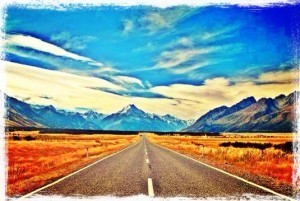 A Note to Mother By MaiLynn Stormon-Trinh
A Note to Mother By MaiLynn Stormon-Trinh
Hello, Mother Nature. I am getting to know you well here in New Zealand and these two little pieces of land hanging off the bottom of your swollen body. You’ve taught me it is possible for all of your beauty and, occasionally, all of your tragedy to fit into a country the size of your bellybutton.
In America, you’ve birthed places like my backyard Sierra Nevadans and the expanse of the yucca tree and sagebrush deserts. The Grand Canyon. The Appalachians. The Alaskan tundra. You’ve given America plenty of wonders. But despite it all, it seems you have lost most of your say in what we do with you.
You’ve tried to wake us with hurricanes on the coasts, tornadoes through the middle, floods, avalanches, earthquakes and all those mighty things you are capable of. But for many Americans, these are fleeting news items. We think little of the Northern Lights or broken levees when we are in an office building or a fast-food drive through. America is too big. You can send your armies of storms and disasters, but the people, we will be the ones who will end up destroying ourselves before you have a chance to do it for us.
Of course, America isn’t your only problem child. You’re greatness is being forgotten all over this planet underneath the overflow of people and our emissions, nuclear dump sites, the hordes of tourists who have worn down and polluted you for little appreciation and a cheap vacation.
I can say these things because I, too, am a culprit. In America, in Europe, in Thailand, in Vietnam, I never really knew you so I never knew how to respect you.
It’s only in Aotearoa, the land of the long white cloud, that I have learned who you are.
On one short road trip, I saw your rugged coastlines and mountains with peaks so high they had disappeared into the puffed clouds above. I was bitten by sand flies on the shores of your lakes, climbed on your glaciers, floated through fjords where your Southern Alps jutted out of the deepest black waters. On another trip, I visited your beech tree forests and camped on the beaches of your most eastern cape. I smelled your internal tumult bubble to the surface in sulphuric pools. I drifted belly up through underground rivers in caves dripping with glowworms and swam all over your wild ocean.
And now, I am feeling firsthand how alive and immediate you can be.
Over the past four months, you’ve been rattling the earth below us. Sending people like me into a state of constant, low-burning panic. You’ve cracked the concrete buildings we put up on top of you and sent us running underneath doorframes and wooden tables, praying these things will be our salvation if you choose to bring it all down around us. But you’ve been kind. No one killed. No one hurt very badly. You’ve moved us just enough to let us know that you will be heard. That even though you have let us chop down native forests to build fish and chip shops and farmland, you were the one to create this country. You were the one to shape it into what it is today. And you will be the one who will one day take it all away.
In New Zealand, there is you. All else is fleeting, a precious gift from you to me for which I will always now be thankful.
ABOUT THE AUTHOR: MaiLynn is a Reno, Nevada native who calls Wellington, New Zealand her home (for now). She blogs about her ever evolving search for home and a sense of “identity” in strange places with strange people all over the planet at tigerbombtales.com.
The post New Zealand: A Note to Mother appeared first on We Said Go Travel.
We Said Go Travel
We Said Go Travel is a global community of over sixteen hundred writers with articles from every continent.
Stories are shared with photos and video from a perspective of the transformative power of travel. We Said Go Travel has hosted live and online events as well as travel writing contests around the world. ...more
- Lisa Niver's profile
- 57 followers


